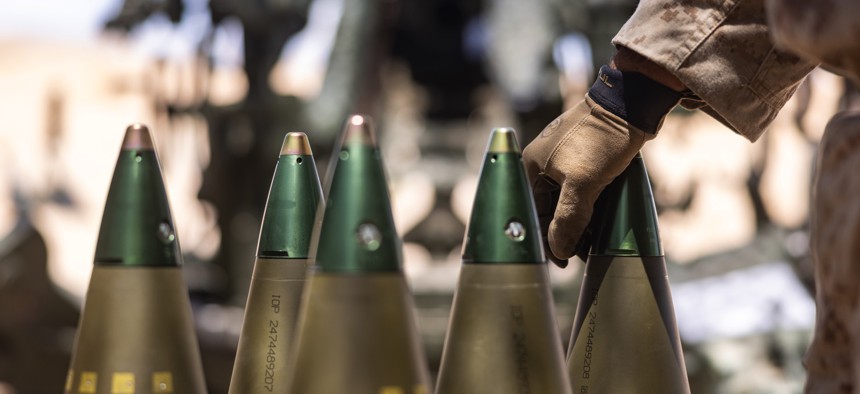
The U.S. Army has nearly tripled its production of 155mm howitzer shells since the Ukraine war began, millions of which have been sent to that country’s front lines. It’s going to miss its goal of making 100,000 per month by October, but likely by just a few months.
The service’s current monthly output stands at 40,000, up from 14,500 when Russia launched its full-scale invasion more than three years ago, according to data provided by the Army. The original plan called for making about twice as many by now.
“Several of the investments that we made are just coming online now, a little later than we had hoped, but these were big bets, and we were given the mission to go fast,” Maj. Gen. John Reim, head of the joint armaments and ammunitions program executive office, told Defense One. “We put multiple bets down, and realized some risk…but we will continue to work through that.”
In February 2024, the Army announced that it aimed to produce 60,000 shells per month that October, 75,000 in April 2025, and 100,000 by this October.
So far the service has funneled nearly $5 billion into the project, mostly through supplemental funding, upgrading existing plants as well as opening new ones. Reim himself has attended seven ribbon-cuttings and groundbreakings.
“You know, I tell folks all the time that we’re literally making history, and that we’ve not seen this level of investment in our industrial base since World War II,” he said.
The investment could be a model for the other services, like the Navy, whose leaders and advocates in Congress have said time and again desperately needs investment in its shipbuilding industrial base.
Making a plan
Most of the Army’s ammunition manufacturing facilities opened during World War II, Reim said. Service leaders made only minimal upgrades to those plants in the decades that followed, a policy that accepted a certain amount of risk, he said.
A new ground war in Europe, and a would-be ally’s desperate cries for anti-tank rounds, forced their hand.
So in 2022, the service submitted the Army Ammunition Plant Modernization Plan. It laid out broad goals like increasing automation and producing more materials in the United States, as well as specific projects, like opening up a facility to produce nitrocellulose – an ingredient in all ammunition propellants – at Radford Army Ammunition Plant in Virginia.
“At the same time, the Ukraine war started to get hot and heavy, and we were given the edict that’s like, ‘hurry up and go fast’,” Reim said.
That included surging production at existing facilities such as the Scranton Army Ammunition Plant.
“They quickly went from a single shift to three shifts, largely running almost 24/7,” Reim said.
A new facility then opened in Mesquite, Texas, with the capacity to crank out 30,000 rounds a month, followed by another in Canada, which is just coming online at a rate of 10,000 a month, he said.
The latest, opening in April in Camden, Arkansas, will crank out another 50,000 per month. Another in Parsons, Kansas, should open later this summer, Reim said, with an estimated rate of 12,000 per month.
Once those are at full production, likely early next year, the Army will surpass that 100,000 rounds-per-month goal.
At the same time, the effort has pushed the Army to re-open old production lines.
The U.S. hasn’t manufactured its own TNT since 1986. Instead, Reim said, the Army had been buying it from Ukraine and Russia, which of course are no longer options. The service has since found vendors in South America, Australia and Asia, and has secured funding for new TNT facilities.
“We’ve learned a lot of lessons from our Ukraine experience, and we’re just so fortunate that we’re learning that now, and not with our blood and treasure on the line,” Reim said.
The post Army expects to make more than a million artillery shells next year appeared first on Defense One.




